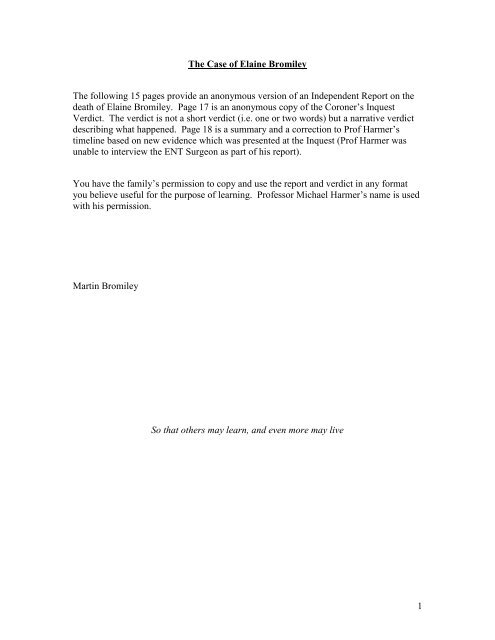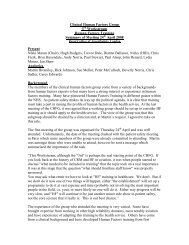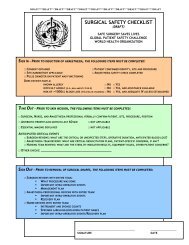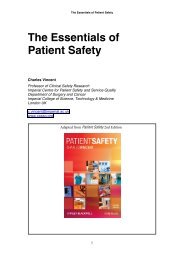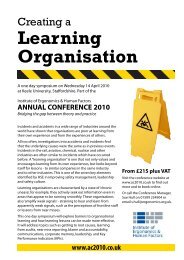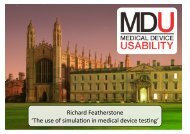Read an anonymous version of Elaine's report, the Inquest Verdict ...
Read an anonymous version of Elaine's report, the Inquest Verdict ...
Read an anonymous version of Elaine's report, the Inquest Verdict ...
You also want an ePaper? Increase the reach of your titles
YUMPU automatically turns print PDFs into web optimized ePapers that Google loves.
The proposed pl<strong>an</strong> was for a general <strong>an</strong>aes<strong>the</strong>tic for <strong>the</strong> procedure. In addition, <strong>an</strong>algesiawas discussed <strong>an</strong>d <strong>the</strong> use <strong>of</strong> rectally-administered dicl<strong>of</strong>enac (a non-steroidal <strong>an</strong>tiinflammatory painkiller) was covered.The blood pressure <strong>an</strong>d haemoglobin levels were within <strong>the</strong> normal r<strong>an</strong>ge for a wom<strong>an</strong> <strong>of</strong>Mrs Bromiley‟s age.There would not appear to be <strong>an</strong>ything <strong>of</strong> particular note in <strong>the</strong> pre-operative <strong>an</strong>aes<strong>the</strong>ticassessment <strong>an</strong>d m<strong>an</strong>agement. The existence <strong>of</strong> a neck problem was identified <strong>an</strong>d itspossible impact predicted by airway assessment. Whilst <strong>the</strong>re was slight restriction inneck movement, <strong>the</strong>re was nothing to suggest that Mrs Bromiley would pose a particularproblem with regard to airway m<strong>an</strong>agement during <strong>an</strong>aes<strong>the</strong>sia. This was <strong>the</strong> impressionDr A had <strong>an</strong>d in his comments he enlarges on his pre-operative findings. With regards to<strong>the</strong> neck problems, <strong>the</strong>re appeared to be little restriction in flexionlextension (headforward <strong>an</strong>d backwards) with only a little limitation in rotation. Mouth opening wasnormal, as was <strong>the</strong> thyro-mental dist<strong>an</strong>ce. The Mallampati score (a measure <strong>of</strong> predicteddifficulty in tracheal intubation) was grade II. Dr A felt that <strong>the</strong>se findings did notconstitute a major difficult airway potential — a view with which I would concur.The proposed <strong>an</strong>aes<strong>the</strong>tic technique as outlined in Dr A‟s comments was to avoidtracheal intubation <strong>an</strong>d maintain <strong>the</strong> airway with a laryngeal mask. Anaes<strong>the</strong>sia was to bemaintained with is<strong>of</strong>lur<strong>an</strong>e (a potent inhaled <strong>an</strong>aes<strong>the</strong>tic agent) carried in a mixture <strong>of</strong>nitrous oxide <strong>an</strong>d oxygen (routine carrier gas mixture). Analgesia would be provided with<strong>an</strong> infusion <strong>of</strong> remifent<strong>an</strong>il (a very potent short-acting <strong>an</strong>algesic). This was, in myopinion, a reasonable proposed technique.Anaes<strong>the</strong>tic m<strong>an</strong>agementa) Pre-<strong>an</strong>aes<strong>the</strong>tic m<strong>an</strong>agementMrs Bromiley was „checked in‟ for surgery by Ms K, senior operating departmentpractitioner <strong>an</strong>d main assist<strong>an</strong>t to Dr A. She noted that <strong>the</strong>re was a history <strong>of</strong> fusedcervical vertebrae <strong>an</strong>d commented upon it. She was assured by Mrs Bromiley that it hadnot been a problem.On arrival in <strong>the</strong> <strong>an</strong>aes<strong>the</strong>tic room at about 08.30, routine monitoring was set up. Thiswas a blood pressure cuff (to measure blood pressure regularly during <strong>the</strong> operation), <strong>an</strong>ECG (monitor <strong>of</strong> heart electrical activity) <strong>an</strong>d a pulse oximeter (monitor <strong>of</strong> <strong>the</strong> oxygenlevel in <strong>the</strong> blood). These are routine monitors that are attached to all patients having ageneral <strong>an</strong>aes<strong>the</strong>tic. This level <strong>of</strong> monitoring is as recommended in <strong>the</strong> AAGBIguidelines. An intravenous c<strong>an</strong>nula was placed in Mrs Bromiley‟s left h<strong>an</strong>d prior toadministration <strong>of</strong> <strong>the</strong> <strong>an</strong>aes<strong>the</strong>tic.Prior to <strong>the</strong> induction <strong>of</strong> <strong>an</strong>aes<strong>the</strong>sia, <strong>the</strong> pulse rate was 81 bpm with <strong>an</strong> oxygen saturation<strong>of</strong> 98% (both normal); <strong>the</strong>re is no record <strong>of</strong> <strong>the</strong> blood pressure at that time. There is norecord <strong>of</strong> a period <strong>of</strong> pre-oxygenation prior to induction <strong>of</strong> <strong>an</strong>aes<strong>the</strong>sia (a procedure thatallows a store <strong>of</strong> oxygen to be in <strong>the</strong> lungs should problems arise).6
) Anaes<strong>the</strong>tic technique <strong>an</strong>d m<strong>an</strong>agement <strong>of</strong> <strong>the</strong> airwayI have endeavoured to construct a timescale for events during <strong>the</strong> <strong>an</strong>aes<strong>the</strong>tic but <strong>the</strong>re isno information recorded on <strong>the</strong> <strong>an</strong>aes<strong>the</strong>tic chart. The following is based on <strong>the</strong> o<strong>the</strong>rclinical notes <strong>an</strong>d comments for staff:08.35 Anaes<strong>the</strong>sia was induced with <strong>an</strong> infusion <strong>of</strong> remifent<strong>an</strong>il (0.3mcglkg/min) <strong>an</strong>d <strong>an</strong>intravenous injection <strong>of</strong> prop<strong>of</strong>ol 200mg (a very rapidly-acting <strong>an</strong>aes<strong>the</strong>tic agent). Theproposed airway m<strong>an</strong>agement was with a flexible laryngeal mask airway but it was notpossible to insert this due to inability to open <strong>the</strong> mouth as a consequence <strong>of</strong> increasedtone in <strong>the</strong> jaw muscles. This c<strong>an</strong> sometimes occur when <strong>an</strong>aes<strong>the</strong>sia is „light‟ <strong>an</strong>d isusually overcome by giving <strong>an</strong> additional dose <strong>of</strong> <strong>an</strong>aes<strong>the</strong>tic. In this case, Dr A gave<strong>an</strong>o<strong>the</strong>r 50 mg <strong>of</strong> prop<strong>of</strong>ol <strong>an</strong>d had a second attempt. He tried two sizes <strong>of</strong> laryngealmask (sizes 3 <strong>an</strong>d 4) but was unable to insert ei<strong>the</strong>r.08.37 At this stage, Mrs Bromiley‟s oxygenation beg<strong>an</strong> to deteriorate <strong>an</strong>d she lookedcy<strong>an</strong>osed (blue). Her oxygen saturation at this time was 75% (<strong>an</strong>ything less th<strong>an</strong> 90% issignific<strong>an</strong>tly low) <strong>an</strong>d her heart rate was raised.08.39 The oxygen saturation continued to deteriorate to a very low level (40%) over <strong>the</strong>next minute or so. Attempts to ventilate <strong>the</strong> lungs with 100% oxygen using a facemask<strong>an</strong>d oral airway proved extremely difficult.08.41-08.43 It was still proving near impossible to ventilate <strong>the</strong> lungs <strong>an</strong>d <strong>the</strong> oxygensaturation remained perilously low (40% - it might have been lower but I think <strong>the</strong>monitor had a lower limit <strong>of</strong> 40%). In combination to <strong>the</strong> extremely low oxygensaturation, <strong>the</strong> heart rate had declined to 69 bpm with a downward trend continuing to <strong>the</strong>low 40‟s. This is indicative <strong>of</strong> lack <strong>of</strong> oxygen to <strong>the</strong> heart.Dr A decided to attempt tracheal intubation at this stage to overcome <strong>the</strong> problems with<strong>the</strong> airway. He gave atropine 0.6 mg intravenously (a drug to counter <strong>the</strong> slow heart rate)<strong>an</strong>d suxamethonium 100 mg (a paralysing drug to allow insertion <strong>of</strong> <strong>the</strong> tracheal tube).At about this time, Dr A was joined by Dr B who had been about to start <strong>an</strong> operating listin <strong>the</strong> adjoining <strong>the</strong>atre.08.45 On insertion <strong>of</strong> <strong>the</strong> laryngoscope to allow insertion <strong>of</strong> <strong>the</strong> tracheal tube, it wasimpossible to see <strong>an</strong>y <strong>of</strong> <strong>the</strong> laryngeal (voicebox) <strong>an</strong>atomy. This view at laryngoscopy isclassified as Connack <strong>an</strong>d Leh<strong>an</strong>e grade IV <strong>an</strong>d me<strong>an</strong>s that tracheal intubation is likely tobe very difficult if not impossible. The oxygen saturation remained very low though <strong>the</strong>heart rate had increased to 64 bpm, probably as a result <strong>of</strong> <strong>the</strong> atropine.By about this time, o<strong>the</strong>r staff had been summoned to <strong>the</strong> <strong>an</strong>aes<strong>the</strong>tic room to provide <strong>an</strong>ynecessary assist<strong>an</strong>ce. Mr E also entered <strong>the</strong> <strong>an</strong>aes<strong>the</strong>tic room at about this time. Betweenattempts at laryngoscopy, ventilation still proved extremely difficult despite <strong>the</strong> use <strong>of</strong>four-h<strong>an</strong>ded attempts.The situation now was that termed „c<strong>an</strong>‟t intubate, c<strong>an</strong>‟t ventilate‟ <strong>an</strong>d is a recognisedemergency in <strong>an</strong>aes<strong>the</strong>tic practice for which guidelines are available.7
08.47-08.50 Fur<strong>the</strong>r attempts at laryngoscopy <strong>an</strong>d intubation were made using differentlaryngoscopes by both Dr A <strong>an</strong>d Dr B, but to no avail as <strong>the</strong> larynx could not be seen. DrB attempted visualisation with a fibre-optic flexible scope but was unable due to <strong>the</strong>presence <strong>of</strong> blood obscuring <strong>the</strong> view through <strong>the</strong> scope.The oxygen saturation remained very low at 40% <strong>an</strong>d <strong>the</strong> heart rate again was beginningto slow.By this time, staff had ensured that all possibly-needed equipment including atracheostomy set was available in <strong>the</strong> <strong>an</strong>aes<strong>the</strong>tic room or in <strong>the</strong> close vicinity.08.51-08.55 Mr E attempted intubation with a st<strong>an</strong>dard <strong>an</strong>aes<strong>the</strong>tic laryngoscope. He wasable to see <strong>the</strong> very end <strong>of</strong> <strong>the</strong> epiglottis (top part <strong>of</strong> <strong>the</strong> larynx) <strong>an</strong>d attempted to pass abougie into <strong>the</strong> larynx over which a tracheal tube could be „railroaded‟. He wasunsuccessful.The oxygen saturation remained low at 40%. There was a recordable blood pressure <strong>an</strong>d<strong>the</strong> heart rate was now high at 140 bpm.08.55 Insertion <strong>of</strong> <strong>an</strong> intubating laryngeal mask allowed some ventilation, though it stillremained difficult to ventilate <strong>the</strong> lungs. At <strong>the</strong> time <strong>of</strong> insertion <strong>of</strong> <strong>the</strong> intubatinglaryngeal mask, <strong>the</strong> oxygen saturation was still low at 40% <strong>an</strong>d <strong>the</strong> pulse rate was high at133 bpm.09.00 The insertion <strong>of</strong> <strong>the</strong> intubating laryngeal mask improved matters <strong>an</strong>d <strong>the</strong> oxygensaturation rose to 90% with a raised blood pressure <strong>an</strong>d heart rate. At this time, a dose <strong>of</strong>steroids (dexamethasone 8 mg) was given, presumably to help protect <strong>the</strong> brain fromhypoxic damage.09.03-09.09 Attempts were made to insert a tracheal tube through <strong>the</strong> intubatinglaryngeal mask. Initially, <strong>the</strong> attempt was undertaken blindly (as <strong>the</strong> device is intended towork) <strong>an</strong>d <strong>the</strong>n using a fibre-optic flexible scope. The latter attempt by Mr E failed as hewas unable to pass <strong>the</strong> scope through <strong>the</strong> end <strong>of</strong> <strong>the</strong> laryngeal mask (a recognisedproblem with this device).During <strong>the</strong>se attempts, <strong>the</strong> oxygen saturation was unstable, dipping down to 49% onoccasion. At no time did it exceed 90%.09.10 In view <strong>of</strong> <strong>the</strong> problems encountered, it was decided to ab<strong>an</strong>don <strong>the</strong> procedure <strong>an</strong>dallow Mrs Bromiley to wake up.09.13-09.29 During this time, <strong>the</strong> remifent<strong>an</strong>il infusion was stopped <strong>an</strong>d spont<strong>an</strong>eousbreathing beg<strong>an</strong> (up till that time, <strong>the</strong> lungs had been ventilated by squeezing <strong>the</strong> bag on<strong>the</strong> <strong>an</strong>aes<strong>the</strong>tic machine). The laryngeal mask was removed <strong>an</strong>d <strong>an</strong> oral airway inserted.Oxygen saturations gradually improved reaching near normal levels <strong>of</strong> 95%. Throughoutthis time, <strong>the</strong> blood pressure was markedly elevated (as high as 192/126 mmflg) <strong>an</strong>d <strong>the</strong>heart rate was also very high (up to 152 bpm).Once Dr A was happy that Mrs Bromiley was breathing satisfactorily with <strong>the</strong> oralairway in place, she was tr<strong>an</strong>sferred to <strong>the</strong> recovery room. At this time, Dr A thought thatMrs Bromiley was showing signs <strong>of</strong> recovery <strong>an</strong>d was breathing with a normal pattern.8
In total, during <strong>the</strong> attempts at intubation, Mrs Bromiley‟s oxygen saturation wasextremely low (at or less th<strong>an</strong> 40%) for some 20 minutes.Immediate postoperative careMrs Bromiley was admitted to <strong>the</strong> recovery room at 09.30. Her observations onadmission were a pulse rate <strong>of</strong> 120 bpm, a respiratory rate <strong>of</strong> 20 bpm, blood pressure <strong>of</strong>84/33 mmHg, temperature <strong>of</strong> 35.1 °C <strong>an</strong>d <strong>an</strong> oxygen saturation <strong>of</strong> 95%. The recoverystaff were aware <strong>of</strong> <strong>the</strong> problems that had occurred <strong>an</strong>d were informed by Dr A that hewould expect Mrs Bromiley to recover consciousness slowly. After a short while withMrs Bromiley, Dr A left <strong>the</strong> recovery room to continue <strong>the</strong> operating list.It is clear from <strong>the</strong> statements <strong>of</strong> <strong>the</strong> recovery staff (Nurses D <strong>an</strong>d S) <strong>an</strong>d subsequentinterviews that <strong>the</strong>y were far from happy with Mrs Bromiley‟s condition. Even nearly onehour after admission, <strong>the</strong>re was no sign <strong>of</strong> recovery <strong>of</strong> consciousness <strong>an</strong>d whilst MrsBromiley was breathing, <strong>the</strong> pattern was erratic. The blood pressure was equally erraticwith swings from very high to low; <strong>the</strong> oxygen saturation equally showed swings. Mostconcerning to <strong>the</strong> recovery staff were periodic episodes <strong>of</strong> movement that looked like„fits‟. These were associated with fur<strong>the</strong>r swings in measured parameters. Such are signs<strong>of</strong> cerebral irritation <strong>an</strong>d require prompt, appropriate action.On several occasions, <strong>the</strong> recovery staff asked Dr A to come to see Mrs Bromiley but thatwas not always possible as he had already started to <strong>an</strong>aes<strong>the</strong>tise <strong>the</strong> next patient on <strong>the</strong>operating list. On occasion, Dr B came to see <strong>the</strong> patient, but he, quite legitimately, had aduty <strong>of</strong> care to his own patients. The exact times when requests were made <strong>of</strong> Dr A arenot recorded but it is clear that <strong>the</strong> recovery staff felt that Dr A should have been readilyavailable to deal with <strong>an</strong>y problems.Concerns increased <strong>an</strong>d eventually it was decided that Mrs Bromiley needed to betr<strong>an</strong>sferred to <strong>the</strong> intensive care unit. As both Dr A <strong>an</strong>d Dr B were unavailable, (<strong>an</strong>o<strong>the</strong>rAnae<strong>the</strong>tist) attended to supervise <strong>the</strong> tr<strong>an</strong>sfer. This took place at about 11.00 <strong>an</strong>d MrsBromiley was tr<strong>an</strong>sferred to (NHS) Hospital. At this time, she was in <strong>an</strong> unstablecondition though was still breathing on her own.The exact sequence <strong>of</strong> events is not entirely clear as <strong>the</strong>re is no record <strong>of</strong> measurementsmade. It is normal practice to have written records <strong>of</strong> cardiovascular variables <strong>an</strong>d I c<strong>an</strong>only assume that if such exists, that it has been mislaid.Subsequent m<strong>an</strong>agementIt was not within <strong>the</strong> brief <strong>of</strong> this inquiry to consider <strong>the</strong> m<strong>an</strong>agement <strong>of</strong> Mrs Bromileyoutside The xx Clinic <strong>an</strong>d hence this section reflects <strong>an</strong> overview <strong>of</strong> <strong>the</strong> situation.On admission to <strong>the</strong> intensive care unit at (NHS) Hospital, it was clear that Mrs Bromileyhad suffered marked brain damage <strong>an</strong>d urgently required ventilation. Again <strong>the</strong>re wereproblems with placing a tracheal tube, finally it was possible to insert one through hernose <strong>an</strong>d into her trachea.Mrs Bromiley‟s condition did not improve <strong>an</strong>d her clinical course lead to her ultimatedeath. There was clear evidence <strong>of</strong> severe cerebral damage through her time on <strong>the</strong>intensive care unit.9
Appropriateness <strong>of</strong> clinical m<strong>an</strong>agementThere are a number <strong>of</strong> areas where <strong>the</strong> clinical m<strong>an</strong>agement <strong>of</strong> Mrs Bromiley fell short <strong>of</strong>what one might reasonably expect. It is impossible to say what would have happened ifher m<strong>an</strong>agement had been different, as this was <strong>an</strong> unusual case as <strong>the</strong>re was little tosuggest <strong>the</strong> extent <strong>of</strong> <strong>the</strong> problem that was encountered.In order to provide some structure to this section, I shall tackle <strong>the</strong> areas in achronological order pointing out where I believe m<strong>an</strong>agement was acceptable <strong>an</strong>d where<strong>the</strong>re was, in my opinion, inappropriate m<strong>an</strong>agement.Facilities <strong>an</strong>d staff at The xx ClinicThere was nothing lacking in <strong>the</strong> staffing <strong>an</strong>d facilities at The xx Clinic. The one piece <strong>of</strong>equipment that was not available on <strong>the</strong> day <strong>of</strong> <strong>the</strong> incident is not essential <strong>an</strong>d would notbe present in every hospital. The st<strong>an</strong>dard <strong>of</strong> care given by <strong>the</strong> staff was, in my opinion,exemplary.Pre-operative assessment <strong>an</strong>d preparationThe pre-operative assessment that took place on 21 March 2005 was entirely adequate<strong>an</strong>d investigations were appropriate.The pre-operative assessment made by Dr A on <strong>the</strong> day <strong>of</strong> surgery was equallyappropriate <strong>an</strong>d adequate. He had identified <strong>an</strong>d, to <strong>the</strong> best <strong>of</strong> his abilities, qu<strong>an</strong>tified <strong>the</strong>potential risk associated with <strong>the</strong> neck stiffliess. The bedside tests he undertook wereentirely appropriate <strong>an</strong>d represent good practice. His opinion was that whilst <strong>the</strong>re was apotential problem, it did not represent a major hazard — <strong>an</strong> opinion with which I wouldagree.Thus, I do not feel that <strong>the</strong>re was <strong>an</strong>ything in <strong>the</strong> pre-operative assessment <strong>an</strong>dm<strong>an</strong>agement that was <strong>an</strong>ything but good <strong>an</strong>d appropriate practice.Anaes<strong>the</strong>tic techniqueThe choice <strong>of</strong> a general <strong>an</strong>aes<strong>the</strong>tic for this procedure was appropriate <strong>an</strong>d <strong>the</strong> drugs usedwere those with which Dr A was familiar. There are m<strong>an</strong>y options for which agents onemight use for such <strong>an</strong> operation, <strong>an</strong>d those chosen are quite appropriate.It is some <strong>an</strong>aes<strong>the</strong>tists‟ practice to routinely give <strong>the</strong> patient 100% oxygen to breath for afew minutes prior to induction <strong>of</strong> <strong>an</strong>aes<strong>the</strong>sia. This allows <strong>the</strong> washing out <strong>of</strong> nitrogenfrom <strong>the</strong> lungs <strong>an</strong>d its replacement with oxygen that provides a store should problemsarise in <strong>the</strong> early part <strong>of</strong> <strong>the</strong> <strong>an</strong>aes<strong>the</strong>tic. It is my practice to routinely do this but m<strong>an</strong>y<strong>an</strong>aes<strong>the</strong>tists do not unless <strong>the</strong>re is a specific indication. There was no specific indicationin this case <strong>an</strong>d it probably is a reflection <strong>of</strong> Dr A‟s normal practice. I do not considerpre-oxygenation to be m<strong>an</strong>datory in a case such as this.10
Intended airway m<strong>an</strong>agementThe intended method <strong>of</strong> airway m<strong>an</strong>agement for <strong>the</strong> procedure (use <strong>of</strong> a laryngeal maskairway) was particularly appropriate as not only did it allow good surgical access, iteliminated <strong>the</strong> need for tracheal intubation, If <strong>the</strong> neck problem was to present a problem,it would be in tracheal intubation; by avoiding intubation, <strong>the</strong>oretically <strong>an</strong>y problemwould be avoided.When it was impossible to insert <strong>the</strong> laryngeal mask airway, it was assumed that it was asa result <strong>of</strong> muscle tone caused by light <strong>an</strong>aes<strong>the</strong>sia. This is entirely reasonable <strong>an</strong>d is <strong>an</strong>ot uncommon problem. An additional small dose <strong>of</strong> <strong>an</strong>aes<strong>the</strong>tic is usually enough toallow insertion. I would agree with this course <strong>of</strong> action.When it was not possible to insert <strong>the</strong> laryngeal mask or to inflate <strong>the</strong> lungs with a „bag<strong>an</strong>d mask‟, it is necessary to take appropriate actions. In <strong>the</strong> h<strong>an</strong>ds <strong>of</strong> <strong>an</strong> experienced<strong>an</strong>aes<strong>the</strong>tist such as Dr A, <strong>the</strong> most appropriate action at this stage is tracheal intubation.He administered <strong>the</strong> muscle relax<strong>an</strong>t, suxamethonium, <strong>an</strong>d quite reasonably would haveexpected to be able to see <strong>the</strong> larynx <strong>an</strong>d place a tracheal tube. When this was notpossible, he was confronted with one <strong>of</strong> <strong>the</strong> most feared <strong>an</strong>aes<strong>the</strong>tic situations <strong>of</strong> a patientwho you c<strong>an</strong>not intubate or ventilate who is hypoxic (lack <strong>of</strong> oxygen).I believe that Dr A‟ s actions up to this point are appropriate <strong>an</strong>d in keeping withacceptable practice.M<strong>an</strong>agement <strong>of</strong> ‘C<strong>an</strong> ‘t intubate, c<strong>an</strong>’t ventilate’This situation is <strong>an</strong> emergency <strong>an</strong>d requires rapid <strong>an</strong>d appropriate action if it is not to endin disaster. Over <strong>the</strong> years <strong>the</strong>re have been m<strong>an</strong>y „failed intubation drills‟ published withdifferent lines <strong>of</strong> action. In recent years, <strong>the</strong> Difficult Airway Society (DAS) hasproduced guidelines for exactly this eventuality (copy attached at end <strong>of</strong> <strong>report</strong>). They arebased on <strong>the</strong> one underlying import<strong>an</strong>t measure — to ensure <strong>the</strong> return <strong>of</strong> adequateoxygenation as soon as possible. The guidelines are intended primarily for <strong>the</strong> situationwhere intubation is <strong>the</strong> first airway m<strong>an</strong>agement technique used <strong>an</strong>d so are not entirelyappropriate in this case. The guidelines for unexpected difficult intubation consist <strong>of</strong>pl<strong>an</strong>s A, B, C <strong>an</strong>d D. As c<strong>an</strong> be see, <strong>the</strong>y are fairly easy to follow <strong>an</strong>d have been widelypublicised in <strong>the</strong> journals recently.I would have expected Dr A to follow <strong>the</strong> guidelines in ensuring adequate oxygenation as<strong>the</strong> first priority in this case ra<strong>the</strong>r th<strong>an</strong> persistent attempts at intubation. The DASguidelines suggest <strong>an</strong> intubating laryngeal mask as <strong>the</strong> Pl<strong>an</strong> B when intubation has failed.Although this was <strong>the</strong> method eventually used by Dr A, more th<strong>an</strong> 20 minutes had passedsince Mrs Bromiley first became hypoxic. It is a well-known fact that persistent attemptsat intubation when one is unable to ventilate <strong>the</strong> lungs between attempts is a very seriousmatter <strong>an</strong>d <strong>of</strong>ten has <strong>an</strong> untoward outcome with hypoxic brain damage. For that reason,when in a situation <strong>of</strong> „c<strong>an</strong>‟t intubate, c<strong>an</strong>‟t ventilate‟, early recourse to providing <strong>an</strong>alternative route to <strong>the</strong> airway is advocated ei<strong>the</strong>r by surgical or percut<strong>an</strong>eouscricothyrotomy.11
These are well recognised techniques that all <strong>an</strong>aes<strong>the</strong>tists should be familiar with <strong>an</strong>d beable to perform. In this case, both <strong>the</strong> equipment <strong>an</strong>d appropriate staff were available toperform <strong>the</strong> procedure; <strong>the</strong> presence <strong>of</strong> <strong>an</strong> ENT surgeon is <strong>an</strong> added bonus in thissituation <strong>an</strong>d he would have been able to undertake <strong>the</strong> surgical procedure, if Dr A hadbeen unable to perform a percut<strong>an</strong>eous technique.It is hard to underst<strong>an</strong>d why Dr A, <strong>an</strong>d those with him, persevered in trying to intubate<strong>the</strong> trachea when st<strong>an</strong>dard teaching would be to ensure oxygenation within three minutes<strong>of</strong> <strong>the</strong> start <strong>of</strong> severe hypoxia. It is particularly difficult to underst<strong>an</strong>d when <strong>an</strong>experienced ENT surgeon was actually in <strong>the</strong> room. To attempt intubation by <strong>the</strong> m<strong>an</strong>ymethods caused fur<strong>the</strong>r delay in a definitive solution. However, when in such <strong>an</strong>emergency situation, it is surprising how quickly time goes by <strong>an</strong>d whilst concentratingon solving <strong>the</strong> intubation problem, I suspect that Dr A was not aware <strong>of</strong> how much timehad passed. In my interview with him, he said he had no idea that some much time hadpassed <strong>an</strong>d had he been aware <strong>of</strong> <strong>the</strong> passage <strong>of</strong> time, he would have resorted to a surgicalaccess to <strong>the</strong> airway. He still does not know why he did not do so. The problem <strong>of</strong> <strong>the</strong>passage <strong>of</strong> time is well known <strong>an</strong>d yet such information is seldom provided in situationssuch as this; some form <strong>of</strong> regular prompting would be very helpful.Thus, I believe that <strong>the</strong> m<strong>an</strong>agement <strong>of</strong> <strong>the</strong> „c<strong>an</strong>‟t intubate, c<strong>an</strong>‟t ventilate‟ situation leftsomething to be desired <strong>an</strong>d certainly did not follow <strong>the</strong> current guid<strong>an</strong>ce in this matter.Even if <strong>the</strong> guidelines had been followed, <strong>the</strong>re is no guar<strong>an</strong>tee that <strong>the</strong> outcome wouldhave been different but patients have survived similar unexpected events whereemergency airway access has been provided.Fur<strong>the</strong>r attempts at intubation through <strong>the</strong> intubating laryngeal maskWhilst one c<strong>an</strong> underst<strong>an</strong>d <strong>the</strong> desire to secure <strong>the</strong> airway with a tracheal tube, it wasdebatable why, when oxygenation was improving, fur<strong>the</strong>r attempts were made to performthis task with deleterious effects. It is recognised that blind intubation through <strong>the</strong>intubating laryngeal mask is not always successful, even though <strong>the</strong> apparatus is designedto be used this way. For that reason, most <strong>an</strong>aes<strong>the</strong>tists experienced in this area will use afibre-optic scope to place <strong>the</strong> tube through <strong>the</strong> laryngeal mask. At <strong>the</strong> end <strong>of</strong> <strong>the</strong>intubating laryngeal mask is a flap that has to be negotiated; contrary to Mr E‟s assertionthat this is normally cut <strong>of</strong>f before use in this situation, it is negotiated by first pushing atracheal tube through before passing <strong>the</strong> scope. It is <strong>of</strong> some concern that both Mr E <strong>an</strong>dboth <strong>an</strong>aes<strong>the</strong>tists seemed unaware <strong>of</strong> this well-known fact <strong>an</strong>d fur<strong>the</strong>r begs <strong>the</strong> questionas to whe<strong>the</strong>r fur<strong>the</strong>r attempts at intubation should have been undertaken if <strong>the</strong> operator isnot familiar with <strong>the</strong> equipment. The need for intubation at this time in this setting isparticularly pertinent as <strong>the</strong> DAS guidelines would suggest that if <strong>the</strong> surgical procedureis elective <strong>an</strong>d ventilation <strong>an</strong>d oxygenation has been achieved, <strong>the</strong>re should be noconsideration <strong>of</strong> continuing with <strong>the</strong> case but one should immediately awaken <strong>the</strong> patient.12
Decision to awaken <strong>the</strong> patientAs already implied above, in <strong>an</strong> elective situation where <strong>the</strong>re has been problems inventilation which have been overcome, <strong>the</strong>re is really no indication for keeping <strong>the</strong>patient <strong>an</strong>aes<strong>the</strong>tised <strong>an</strong>d <strong>the</strong>y should be allowed to regain spont<strong>an</strong>eous breathing <strong>an</strong>dwake up. This will allow consideration <strong>of</strong> <strong>the</strong> problem <strong>an</strong>d development <strong>of</strong> <strong>an</strong> alternatestrategy for <strong>the</strong> future.However, in a situation such as with Mrs Bromiley where <strong>the</strong>re has been <strong>an</strong> extensiveperiod <strong>of</strong> gross hypoxia (up to 20 minutes) it is almost inevitable that <strong>the</strong>re will be at leastsome cerebral irritation or fr<strong>an</strong>k damage. Such damage c<strong>an</strong> be minimised by ensuring that<strong>the</strong>re is continuing adequate oxygenation <strong>an</strong>d ventilation. The development <strong>of</strong> inadequateventilation leads to a reduced oxygen <strong>an</strong>d increased carbon dioxide level, both <strong>of</strong> whichare detrimental to <strong>the</strong> brain in its damaged condition. After such a prolonged hypoxicperiod, it would be best to provide a period <strong>of</strong> controlled ventilation <strong>an</strong>d brain monitoringra<strong>the</strong>r th<strong>an</strong> attempting to wake up <strong>the</strong> patient <strong>an</strong>d leaving <strong>the</strong>m with potentially reducedventilation.To follow this line would require tracheal intubation which is already known to bedifficult, if not impossible. In my opinion, this was <strong>an</strong>o<strong>the</strong>r time when surgical airwayaccess should have been considered as it would not only have provided a secure airwaybut also have allowed optimal postoperative ventilatory care.Tr<strong>an</strong>sfer to recoveryGiven <strong>the</strong> prolonged period <strong>of</strong> hypoxia, I believe that Mrs Bromiley should have beenadmitted to <strong>an</strong> intensive care unit. She should have had a secure airway inserted <strong>an</strong>d herlungs ventilated. In addition she should have had invasive monitoring instituted to allowoptimal m<strong>an</strong>agement <strong>of</strong> blood pressure. All <strong>the</strong> expertise <strong>an</strong>d equipment to undertake thiswas available in <strong>the</strong> operating <strong>the</strong>atre at The xx Clinic. To send her to recovery in <strong>an</strong>unconscious state <strong>an</strong>d breathing spont<strong>an</strong>eously was inappropriate <strong>an</strong>d would not havehelped <strong>an</strong>y existing cerebral damage.H<strong>an</strong>dover <strong>of</strong> care in recoveryGiven her poor state on admission to recovery, I am surprised that <strong>the</strong> nurses accepted <strong>the</strong>tr<strong>an</strong>sfer <strong>of</strong> care <strong>of</strong> Mrs Bromiley from Dr A. Although in everyday practice, this formaltr<strong>an</strong>sfer <strong>of</strong> responsibility is „a taken‟, in such a situation, I would expect a specific <strong>an</strong>ddetailed discussion <strong>an</strong>d formal h<strong>an</strong>dover <strong>of</strong> care. During my interviews with <strong>the</strong> recoverynurses, it was clear that no such process occurred. In defence <strong>of</strong> Dr A, if <strong>the</strong>re was n<strong>of</strong>ormal tr<strong>an</strong>sfer process in everyday practice, he may have assumed that <strong>the</strong> nurses werehappy.13
If <strong>the</strong>re had been no proper tr<strong>an</strong>sfer <strong>of</strong> care from Dr A to <strong>the</strong> recovery nurses, it wasentirely inappropriate for him to go back to <strong>the</strong>atre <strong>an</strong>d start <strong>an</strong>o<strong>the</strong>r operation; he has acontinuing duty <strong>of</strong> care to his patients that has not been discharged. Even if <strong>the</strong>re hadbeen a tr<strong>an</strong>sfer <strong>of</strong> care, in such a case, I would expect <strong>the</strong> <strong>an</strong>aes<strong>the</strong>tist to stay with <strong>the</strong>patient until <strong>the</strong>y had recovered <strong>an</strong>d to find someone else to <strong>an</strong>aes<strong>the</strong>tise <strong>the</strong> rest <strong>of</strong> <strong>the</strong>operating list. The situation with Mrs Bromiley was far from satisfactory as <strong>the</strong> recoverynurses were not given <strong>the</strong> appropriate support from Dr A <strong>an</strong>d <strong>the</strong>y became increasinglyconcerned about her condition. From <strong>the</strong> statements <strong>of</strong> <strong>the</strong> recovery nurses <strong>an</strong>d both<strong>an</strong>aes<strong>the</strong>tists, it is clear that <strong>the</strong>re were obvious signs <strong>of</strong> cerebral irritation that neededintensive care.Care in recoveryGiven her condition <strong>an</strong>d <strong>the</strong> inappropriateness <strong>of</strong> her tr<strong>an</strong>sfer to recovery, I believe that<strong>the</strong> recovery staff provided good care to Mrs Bromiley. They were clearly concernedabout her condition but did not seem to have <strong>the</strong> degree <strong>of</strong> support that <strong>the</strong>y might expectfrom Dr A. If <strong>the</strong>re is a criticism, it relates to <strong>the</strong> lack <strong>of</strong> written recording for <strong>the</strong> period<strong>of</strong> stay in recovery. Having spoken to <strong>the</strong> staff involved, I believe that <strong>the</strong> record musthave been mislaid.Tr<strong>an</strong>sfer to intensive care unitAs I have already stated, in my opinion, Mrs Bromiley should not have been admitted torecovery but gone directly to intensive care, but only after a patent airway had beensecured. In <strong>the</strong> event, when it was decided to tr<strong>an</strong>sfer Mrs Bromiley, it was done withouta secured airway. When she arrived at (NHS) Hospital, <strong>the</strong>re were again problems withintubation <strong>an</strong>d only after several attempts was it possible to pass a tracheal tube <strong>an</strong>dsecure <strong>the</strong> airway.It would have been more appropriate, in my opinion, for Mrs Bromiley to have had herairway secured before tr<strong>an</strong>sfer. Those already in <strong>the</strong> <strong>the</strong>atres were aware <strong>of</strong> <strong>the</strong> problems<strong>an</strong>d would have thought out how to get around <strong>the</strong> difficulties, or <strong>the</strong>y could havesummoned appropriate skilled assist<strong>an</strong>ce from o<strong>the</strong>r colleagues elsewhere to come to Thexx Clinic where all <strong>the</strong> necessary staff <strong>an</strong>d equipment were available. Tr<strong>an</strong>sferring such<strong>an</strong> unstable patient without a secure airway was <strong>an</strong> unnecessary risk.M<strong>an</strong>agement in (NHS) General HospitalAs I alluded to earlier, this is <strong>an</strong> area <strong>of</strong> care outside <strong>the</strong> terms <strong>of</strong> reference for <strong>the</strong> inquirybut I believe, Mrs Bromiley received <strong>the</strong> best possible care but unfortunately <strong>the</strong> damageto her brain caused by <strong>the</strong> prolonged period <strong>of</strong> hypoxia was so extensive that recoverywas unlikely.14
Conclusions <strong>an</strong>d suggested actionsAs is clear from <strong>the</strong> <strong>report</strong>, I believe that Mrs Bromiley suffered severe cerebral damageas a result <strong>of</strong> her extended period <strong>of</strong> hypoxia subsequent upon <strong>the</strong> unexpected difficultyin maintaining her airway during <strong>an</strong>aes<strong>the</strong>sia.The staff <strong>an</strong>d facilities at The xx Clinic are <strong>of</strong> a high st<strong>an</strong>dard. There is a good level <strong>of</strong>equipment in <strong>the</strong> hospital to deal with difficult airways. The only piece <strong>of</strong> equipment notavailable at <strong>the</strong> time <strong>of</strong> my visit in May was <strong>an</strong> Aintree Ca<strong>the</strong>ter. It would be prudent toprovide this piece <strong>of</strong> equipment.Suggested action: Purchase <strong>of</strong> Aintree Ca<strong>the</strong>ter for use in difficult intubationThe pre-operative assessment <strong>an</strong>d <strong>an</strong>aes<strong>the</strong>tic m<strong>an</strong>agement was <strong>of</strong> <strong>an</strong> appropriatest<strong>an</strong>dard as was <strong>the</strong> choice <strong>of</strong> <strong>an</strong>aes<strong>the</strong>tic technique <strong>an</strong>d drugs.The initial airway m<strong>an</strong>agement was appropriate <strong>an</strong>d in keeping with acceptable practice.The m<strong>an</strong>agement <strong>of</strong> <strong>the</strong> „c<strong>an</strong>‟t intubate, c<strong>an</strong>‟t ventilate‟ situation did not follow <strong>the</strong>accepted Difficult Airway Society guidelines. In particular too much time was taken intrying to intubate <strong>the</strong> trachea ra<strong>the</strong>r th<strong>an</strong> concentrating on ensuring adequate oxygenationby o<strong>the</strong>r me<strong>an</strong>s such as direct access to <strong>the</strong> trachea. Whilst <strong>the</strong>atre staff ensured that allnecessary equipment was available, <strong>the</strong> clinici<strong>an</strong>s appeared to become oblivious to <strong>the</strong>passing <strong>of</strong> time <strong>an</strong>d thus lost opportunities to limit <strong>the</strong> extent <strong>of</strong> damage caused by <strong>the</strong>prolonged period <strong>of</strong> hypoxia. Given <strong>the</strong> skill mix <strong>of</strong> <strong>the</strong> clinici<strong>an</strong>s, it would have beenvery easy to perform a surgical procedure to gain access to <strong>the</strong> trachea. Theatre staff,when interviewed, all seemed surprised that such was not performed. Suggested action:Ensure <strong>an</strong> atmosphere <strong>of</strong> good communication in <strong>the</strong> operating <strong>the</strong>atre such that <strong>an</strong>ymember <strong>of</strong> staff feels comfortable to make suggestions on treatment.The Difficult Airway Society guidelines are fairly new (2004) <strong>an</strong>d it may be useful tohave copies <strong>of</strong> <strong>the</strong>m on display in <strong>the</strong> <strong>an</strong>aes<strong>the</strong>tic rooms to act as a prompt should such <strong>an</strong>event occur again.Suggested action: Obtain <strong>an</strong>d display a set <strong>of</strong> <strong>the</strong> latest DAS guidelines in each<strong>an</strong>aes<strong>the</strong>tic roomGiven <strong>the</strong> problem with time passing unnoticed, should such <strong>an</strong> event occur again, amember <strong>of</strong> staff should be allocated to record timings <strong>of</strong> events <strong>an</strong>d keep all involvedaware <strong>of</strong> <strong>the</strong> elapsed time.Suggested action: Develop a protocol to ensure that when <strong>an</strong>y emergency event occurs,be it in <strong>the</strong> <strong>an</strong>aes<strong>the</strong>tic room or <strong>the</strong> operating <strong>the</strong>atre, <strong>the</strong>re is someone designated to keepfull contempor<strong>an</strong>eous records <strong>of</strong> <strong>the</strong> event <strong>an</strong>d to provide <strong>an</strong> elapsed time prompt. It wasclear that clinici<strong>an</strong>s were not entirely familiar with some <strong>of</strong> <strong>the</strong> particular peculiarities <strong>of</strong>some <strong>of</strong> <strong>the</strong> equipment used. This might be rectified by a study day on difficult airwaym<strong>an</strong>agement for all staff including clinici<strong>an</strong>s.15
Suggested action: Org<strong>an</strong>isation <strong>of</strong> a study day on airway m<strong>an</strong>agement with particularreference to equipment not regularly used <strong>an</strong>d <strong>an</strong>y particular peculiarities.There was no written record <strong>of</strong> events during <strong>the</strong> <strong>an</strong>aes<strong>the</strong>tic. A full chart should alwaysbe written whatever <strong>the</strong> situation. This is <strong>the</strong> responsibility <strong>of</strong> <strong>the</strong> <strong>an</strong>aes<strong>the</strong>tist but couldbe reinforced by recovery staff not accepting <strong>the</strong> care <strong>of</strong> a patient without a completedchart.Suggested action: Ensure that all patients have a completed <strong>an</strong>aes<strong>the</strong>tic record beforetr<strong>an</strong>sfer to <strong>the</strong> recovery area.There was no clear tr<strong>an</strong>sfer <strong>of</strong> care in this case between Dr A <strong>an</strong>d <strong>the</strong> recovery staff. Amore robust, formal h<strong>an</strong>dover would make it much clearer to all who is responsible for<strong>the</strong> patient. Unless <strong>the</strong> recovery staff are happy to accept <strong>the</strong> care <strong>of</strong> <strong>the</strong> patient, <strong>the</strong><strong>an</strong>aes<strong>the</strong>tist should not commit to <strong>the</strong> care <strong>of</strong> <strong>an</strong>o<strong>the</strong>r patient.Suggested action: The process <strong>of</strong> tr<strong>an</strong>sfer <strong>of</strong> care from <strong>the</strong> <strong>an</strong>aes<strong>the</strong>tist to <strong>the</strong> recoverystaff should be made more formal so <strong>the</strong>re is no confusion over who carries <strong>the</strong>responsibility for <strong>the</strong> care <strong>of</strong> <strong>the</strong> patient. Under no circumst<strong>an</strong>ce must a clinici<strong>an</strong> committo <strong>the</strong> care <strong>of</strong> <strong>an</strong>o<strong>the</strong>r patient until care <strong>of</strong> <strong>the</strong> previous patient has been tr<strong>an</strong>sferred <strong>an</strong>dthat act is acknowledged.After a major incident such as occurred here, it is inappropriate for <strong>the</strong> staff involved,including <strong>the</strong> clinici<strong>an</strong>s, to continue working immediately. All personnel need time toreflect <strong>an</strong>d ensure that all documentation is completed. Ideally <strong>an</strong>o<strong>the</strong>r team shouldcontinue <strong>the</strong> operating list, but as a minimum <strong>the</strong>re should be a break. Suggested action:Any staff involved in a major incident should have <strong>an</strong> enforced break before continuingwith <strong>an</strong> operating list.Final CommentThis was a tragic case from which m<strong>an</strong>y lessons c<strong>an</strong> <strong>an</strong>d need to be learnt. There werecertainly areas where, in my opinion, <strong>the</strong> clinical practice fell below <strong>an</strong> acceptable level,but even if <strong>the</strong> m<strong>an</strong>agement had been different, <strong>the</strong>re is no way <strong>of</strong> knowing with certaintythat <strong>the</strong> outcome would have been different.Pr<strong>of</strong>essor Michael HarmerMD, FRCA20 July 2005This <strong>report</strong> has been made available by <strong>the</strong> Bromiley family for <strong>the</strong> purpose <strong>of</strong> learning.If you have <strong>an</strong>y questions about this <strong>report</strong> please contact Martin Bromiley on 07980301212 or e-mail martinbromiley@onetel.com16
Mrs Elaine Bromiley presented at <strong>the</strong> xx Clinic, xxxxx on 29 March 2005 for elective surgery forseptoplasty <strong>an</strong>d functional endoscopic sinus surgery. There was slight restriction to her neckmovement but nothing to suggest a problem with airway m<strong>an</strong>agement. On arrival in <strong>the</strong><strong>an</strong>aes<strong>the</strong>tic room routine monitoring was set up, she was not pre-oxygenated. It provedimpossible to insert a flexible laryngeal mask <strong>an</strong>d Mrs. Bromiley‟s oxygenation level beg<strong>an</strong> todeteriorate <strong>an</strong>d she appeared blue. Oxygen saturation deteriorated to a low level <strong>of</strong> 40% <strong>an</strong>d itproved impossible to ventilate her.A recognised emergency “c<strong>an</strong>‟t intubate, c<strong>an</strong>‟t ventilate” arose <strong>an</strong>d <strong>the</strong>re were fur<strong>the</strong>r failedattempts at intubation. A tracheostomy set was called for but was not used. Oxygen saturationlevels remained unstable <strong>an</strong>d at 9.10 <strong>the</strong> proposed surgical procedure was ab<strong>an</strong>doned to allowMrs. Bromiley to wake up.The m<strong>an</strong>agement <strong>of</strong> <strong>the</strong> “c<strong>an</strong>‟t intubate c<strong>an</strong>‟t ventilate” emergency did not follow <strong>the</strong> current or<strong>an</strong>y recognised guid<strong>an</strong>ce. Too much time was taken trying to intubate <strong>the</strong> trachea ra<strong>the</strong>r th<strong>an</strong>concentrating on ensuring adequate oxygenation. The clinici<strong>an</strong>s became oblivious to <strong>the</strong> passing<strong>of</strong> time <strong>an</strong>d thus lost opportunities to limit <strong>the</strong> extent <strong>of</strong> damage caused by <strong>the</strong> prolonged period<strong>of</strong> hypoxia. Not all <strong>the</strong> clinici<strong>an</strong>s were aware that <strong>the</strong>re was a problem with ventilating Mrs.Bromiley.Surgical airway access by ei<strong>the</strong>r tracheotomy or cricothyrotomy should have been considered <strong>an</strong>dcarried out.Given <strong>the</strong> prolonged period <strong>of</strong> hypoxia Mrs Bromiley should have been admitted to <strong>an</strong> intensivecare unit ra<strong>the</strong>r th<strong>an</strong> to <strong>the</strong> recovery room.To send her to recovery in <strong>an</strong> unconscious state <strong>an</strong>d breathing spont<strong>an</strong>eously wasinappropriate. Subsequently tr<strong>an</strong>sferring Mrs. Bromiley to (NHS) Hospital without a secureairway was <strong>an</strong> unnecessary risk.On 5 April 2005 following discussions with <strong>the</strong> family <strong>an</strong>d assessment by senior clinici<strong>an</strong>s adecision was made to withdraw life support treatment <strong>an</strong>d she died on 11 April 2005.This document has been made available by <strong>the</strong> Bromiley family for <strong>the</strong> purpose <strong>of</strong>learning. If you have <strong>an</strong>y questions please contact Martin Bromiley on 07980 301212 ore-mail martinbromiley@onetel.com17
Corrected timeline based on Pr<strong>of</strong> Harmer’s Report <strong>an</strong>d <strong>the</strong> <strong>Inquest</strong> written &verbal evidence.Anaes<strong>the</strong>tist <strong>an</strong>d assist<strong>an</strong>t present, thorough pre-op, no pre-oxygenation0835 Laryngeal mask, GA given, masks didn‟t fit0837 Cy<strong>an</strong>osed, O2 75%0839 O2 40%Starting attempts at Intubation~0841-0843 Heart rate falling, O2 40%, joined by ENT Surgeon, o<strong>the</strong>r Anaes<strong>the</strong>tist <strong>an</strong>dat least 3 Nurses, <strong>the</strong> team <strong>of</strong> Consult<strong>an</strong>ts tried to intubate. One Nurse went out phoneCCU as she was shocked at Elaine‟s vital signs <strong>an</strong>d colour. On return she <strong>an</strong>nounced that“a bed was available in intensive Care”, but <strong>the</strong> Consult<strong>an</strong>ts looked at her as if to say“what‟s wrong, you‟re over-reacting”. She went back to <strong>the</strong> phone <strong>an</strong>d c<strong>an</strong>celled <strong>the</strong> bed.Ano<strong>the</strong>r asked her colleague to fetch <strong>the</strong> Trachy kit. On her return she <strong>an</strong>nounced to <strong>the</strong>consult<strong>an</strong>ts that “<strong>the</strong> tracheostomy set is available” but she was ignored.0845 With hindsight now “c<strong>an</strong>‟t intubate c<strong>an</strong>‟t ventilate”. Consult<strong>an</strong>ts continued toattempt intubation.0900 eventually got some air to Elaine <strong>an</strong>d 90% oxygenation achieved after over 20 minsat 40%0910 Consult<strong>an</strong>ts appear to decide to let Elaine wake up naturally , tr<strong>an</strong>sfer to recoverywhere remained.Summary produced by Martin Bromiley18


